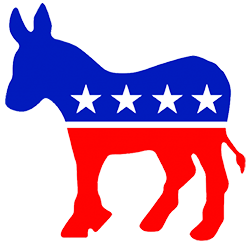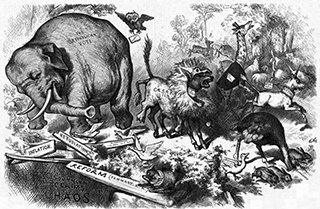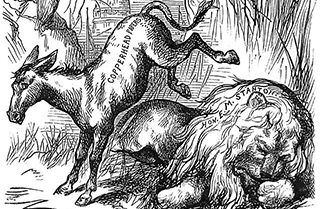The First Political Parties
The symbols for the Republican and Democratic parties are an elephant and a donkey, respectively. Stereotypically, an elephant is large and clumsy, and a donkey is a slow and stubborn. Neither of these animals are a flattering representation of the United States political parties, so how did these animals come to represent them?
 The Democratic Party was the first to inherit its symbol, as the result of an insult during the 1828 presidential election. During the intense campaign, Democrat Andrew Jackson called Republican John Quincy Adams corrupt and spoiled. Adams responded by calling Jackson a donkey, implying that he was slow and dumb.
The Democratic Party was the first to inherit its symbol, as the result of an insult during the 1828 presidential election. During the intense campaign, Democrat Andrew Jackson called Republican John Quincy Adams corrupt and spoiled. Adams responded by calling Jackson a donkey, implying that he was slow and dumb.
Jackson decided to use the insult to his advantage by focusing on the positive characteristics of a donkey. He spoke of the donkey’s persistence, loyalty, and ability to carry a heavy load. Jackson put the donkey on his campaign posters, and it soon became the symbol for the entire Democratic Party.
 The symbol for the Republican Party first appeared during the 1864 presidential election, in which, Republican Abraham Lincoln ran against Democrat George McClellan. A pro-Lincoln newspaper, Father Abraham, published a political cartoon showing an elephant carrying a banner and celebrating the Union victories in the Civil War. This elephant soon came to represent the Republican Party.
The symbol for the Republican Party first appeared during the 1864 presidential election, in which, Republican Abraham Lincoln ran against Democrat George McClellan. A pro-Lincoln newspaper, Father Abraham, published a political cartoon showing an elephant carrying a banner and celebrating the Union victories in the Civil War. This elephant soon came to represent the Republican Party.
The elephant and the donkey were shown in political cartoons by artist Thomas Nast in the newspaper Harper’s Weekly. The first political cartoon shows a large elephant labeled “The Republican Vote” scaring away the other animals at the zoo. The second political cartoon by Nast shows the Democratic donkey kicking a dead lion. These political cartoons popularized the donkey and elephant as the symbols for the respective political parties. Both political cartoons are shown below.
 |
 |